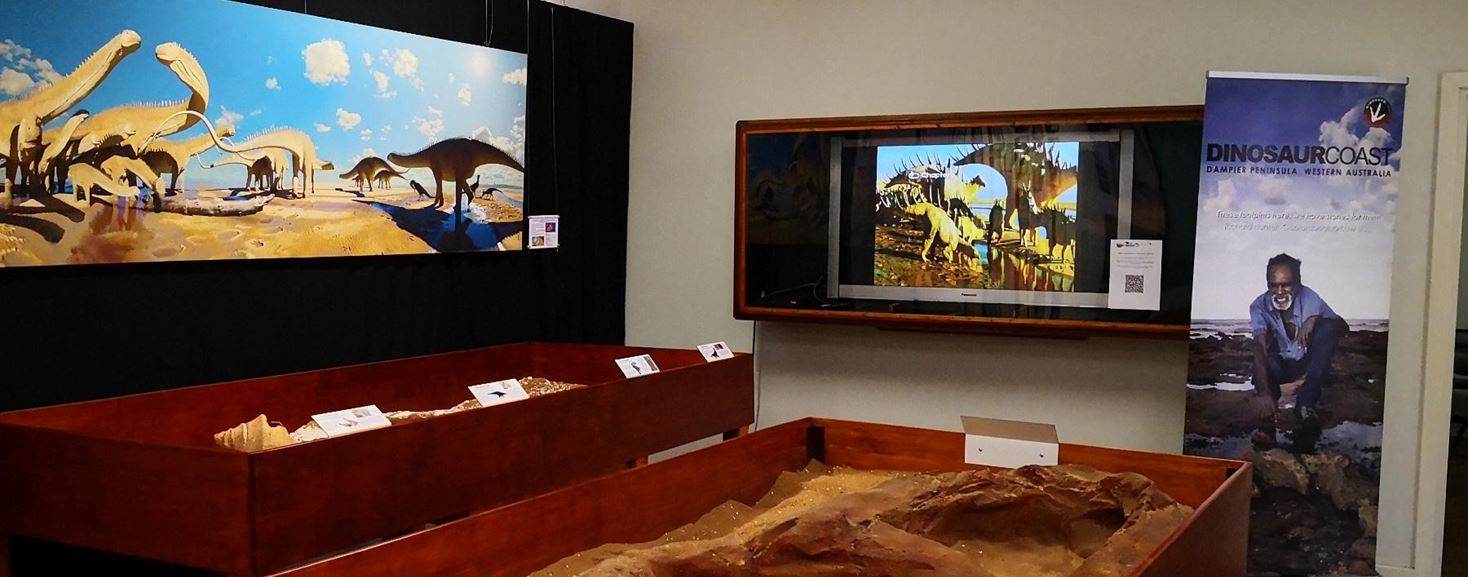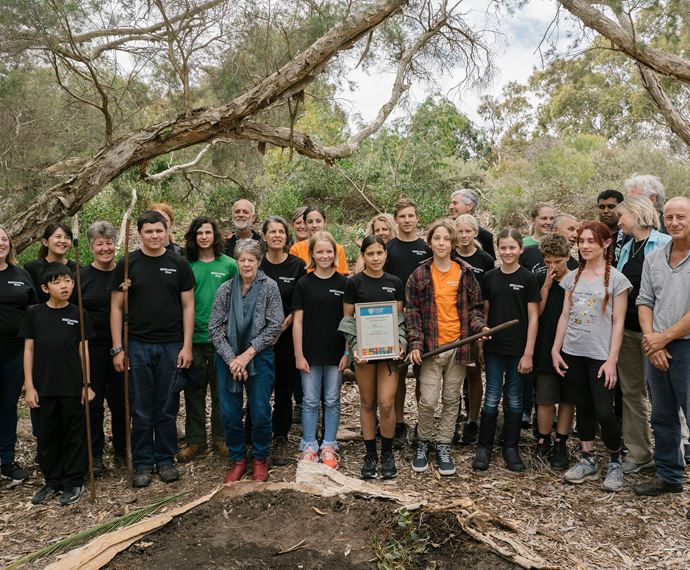Enhancing community engagement with the Dinosaur Coast
The Dinosaur Coast Management Group (DCMG) aims to protect the dinosaur tracks located on the Dampier Peninsula and educate the public about their cultural and scientific importance. The group, which was founded in 2015, works with a range of stakeholders, including Traditional Owners, local community, environmental groups, State, Federal and Local Government, WA Museum, Broome Port Authority and a variety of research partners.
To engage community with the unique natural history of the Dampier Peninsula through the preservation of sandstone dinosaur footprints and the development of a digital app.
Dinosaur Coast Management Group Inc
7/24/2019
$126,691
Lotterywest
$99,815
Pilbara
General Community
- Development of The Dinosaur Coast Track Guide App, which is very popular with the local community and visitors alike.
- Creation of casts of the tracks, which are used for in-school visits creating an interactive educational experience.
- Improvement how volunteers deliver field excursions to ensure they are better aligned to age and subject matter interests.
- The App encouraged people to explore the dinosaur tracks and enabled them to find relevant information while walking alongside the tracks, delivering a more meaningful and engaging experience.
- The development of transportable casts and images of the tracks enabled Dinosaur Coast Management Group to extend the display in the Broome Museum and present in-school visits, increasing community engagement.
- The complexity of developing an App and the required delivery times for specialists wasn’t fully understood at the point of commencement. While the opportunities provided by the App are high, the development was costly and would have benefitted from setting clear expectations and priorities.

Opportunity
Footprints of dinosaurs that roamed the country 130 million years ago have been immortalised in the sandstone along the coast of the Dampier Peninsula in the Kimberley region of WA [1]. The preserved tracks are unique at both a national and international level, as determined by a University of Queensland research study conducted between 2011 to 2016 [2]. Additionally, the tracks hold special significance for Traditional Owners, including the three-toed footprints of Marala (the Emu Man) the ‘law giver’, whose journey across country forms part of the region’s Song Cycle through which traditional knowledge about country is passed from one generation to the next [2] [3]. The Broome Sandstone Dinosaur Footprints was included in the WA Heritage Council List in 2019.
With the tracks positioned along the water’s edge of the Dampier Peninsula, they are potentially at risk of being damaged by future developments in the region [4]. As a result, there was an opportunity to ensure that the cultural and historical significance of the footprints was captured and preserved by the community.
Approach
DCMG delivered a range of interpretative and interactive materials including accessible educational packs and resources, 3D digital visuals, life size track casts and the Dinosaur Coast Track Guide App to enhance community engagement with the unique natural history.
The App brings history to life and encourages visitors to actively engage in the preserved tracks along the Dinosaur Coast. This was made possible through a collaboration between paleo artist Damir Martin from Croatia and scientific advisor Dr Steve Salisbury to develop the visual representations of the dinosaur that left the footprints 130-million-years ago.
Casts and images taken of the tracks enabled DCMG to extend the display in the Broome Museum and have provided visitors with the opportunity to learn more about the tracks.

Impacts and outcomes
Through the development of the App, DCMG has provided dinosaur enthusiasts and interested community members with engaging information about the tracks they see in the Broome sandstone. The Dinosaur Coast Track Guide App is very popular with the local community and visitors alike, ensuring they are informed as they go looking for tracks along Broome’s beaches.
“The Dinosaur Coast Track Guide really helped identify what we were looking at and the kids loved seeing what the dinosaurs looked like.”
Gillian, Broome Local
The casts of the tracks, which are used for in-school visits, have had a significant impact by bringing to life the story of the dinosaurs and local history for the students. By creating casts, the students have been able to touch and explore the different shapes and sizes of the footprint and enjoy an interactive experience.
As part of the grant, DCMG expanded its online activities for families and improved how volunteers deliver field excursions to ensure they are better aligned to age and subject matter interests. The refreshed website has expanded DCMG’s reach within the broader community, and the development of online materials has provided useful resources for families who are home-schooling or looking for holiday activities.
What worked
Providing accessible and engaging information
The App encouraged visitors to explore and enabled them to find relevant information while they walk alongside the tracks in their original setting, delivering a more meaningful experience. DCMG data shows people are using the App regularly and are even connecting back to the group with their own sightings of possible tracks.
“The kids loved all the detail and especially the 360-degree panorama. I will definitely be recommending it to others. Really brought the dinosaurs to life, seeing what they most likely have looked like.”
User testimonial
Key challenges
Understanding technology development costs and timelines
The development of apps can be longer than anticipated, particularly when there are multiple collaborators in diverse locations. DCMG noted that it would have been beneficial to have spent more time working through the complexities of the project and the required delivery times for specialists before commencing development of the App. While implementing modern digital technology provides tremendous opportunities, the group also acknowledged it can be costly, which highlighted the importance of setting clear expectations and priorities.
REFERENCES
- Dinosaur Coast Management Group. (2021). How the tracks formed. Dinosaur Coast Management Group, . Retrieved 24/08/2021 from https://www.dinosaurcoast.org.au/discover/how-tracks-were-formed/
- Salisbury, S. W., Romilio, A., Herne, M. C., Tucker, R. T., & Nair, J. P. (2016). The Dinosaurian Ichnofauna of the Lower Cretaceous (Valanginian–Barremian) Broome Sandstone of the Walmadany Area (James Price Point), Dampier Peninsula, Western Australia. Journal of Vertebrate Paleontology, 36(sup1), 1-152. https://doi.org/10.1080/02724634.2016.1269539
- Goolarabooloo. (2019). The Song Cycle: Goolarabooloo-Looking after Country. Goolarabooloo. http://www.goolarabooloo.org.au/song_cycle.html
- Salisbury, S., & Romilo, A. (2018). Dinosaurian tracks and related geological features of the Reddell Point—Entrance Point area, Broome, Western Australia; palaeontological survey as part of the 2018 Broome Safe Boat Harbour site assessment process. https://www.dinosaurcoast.org.au/wp-content/uploads/2020/09/Salisbury-Romilio-2019-SBH-dinosaur-report.pdf
Learn about wellbeing
Understand how your community is going to help you to better target and plan your project.
Ready to plan your project?
Understand your vision, plan your impact and report on the outcomes of your project with three easy interactive tools in the Community Impact Planner.
Acknowledgement of Country
The Western Australian Community Impact Hub acknowledges and pays respect to the Traditional Owners of the land on which we are based, the Whadjuk people of the Noongar Nation and extends that respect to all the Traditional Owners and Elders of this country. We recognise the significant importance of their cultural heritage, values and beliefs and how these contribute to the positive health and wellbeing of the whole community.
![Mt Gibson Brad Leue AWC[1]](/media/klfbvjje/mt_gibson_brad_leue_awc-1.jpg?anchor=center&mode=crop&width=690&height=570&rnd=133045353289800000&quality=80)
![Carnaby's Cockatoo Flying Over Restoration On Monjebup Reserve. Photo By Krysta Guille[1]](/media/3xkoo5ve/carnaby-s_cockatoo_flying_over_restoration_on_monjebup_reserve-_photo_by_krysta_guille-1.jpg?anchor=center&mode=crop&width=690&height=570&rnd=133053022173100000&quality=80)

